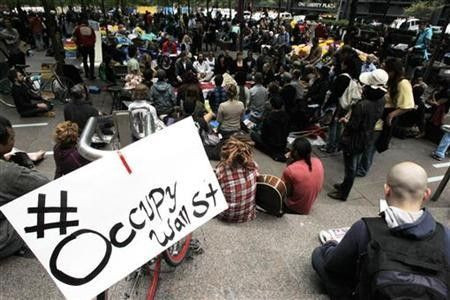Is Occupy Wall Street Protesting in the Wrong ZIP Code?
Analysis

Occupy Wall Street has camped out at Zucotti Park in Lower Manhattan for weeks, but it probably isn't reaching as many bankers as it could.
The area, with its bronze bull statue, the New York Stock Exchange and financial tenants, is forever linked with the financial industry, but finance is no longer the area's biggest tenant.
According to data from the Downtown Alliance, the local business advocacy and research group, government tenants now outnumber financial services, insurance and real estate firms. The City of New York has 5.4 million square feet of office space in the area, while the State of New York has nearly two million square feet.
And while Bank of New York Mellon, Deutsche Bank, Bank of America's Merrill Lynch and AIG still have large presences in the area, and Goldman Sachs occupies a sleek new headquarters at 200 West Street, many of their financier brethren have moved to midtown -- or New Jersey.
A recent exodus of financial firms has occurred at the World Financial Center, the quartet of office towers to the immediate west of the World Trade Center, which is coincidentally owned by Brookfield Properties, also the owner of Zucotti Park.
The accounting giant Deloitte & Touche is moving from World Financial Center to Rockefeller Center, and Japanese bank Nomura will leave for Worldwide Plaza in midtown. Bank of America, whose Merrill Lynch subsidiary remains a big tenant in World Financial, has also announced cutbacks. But Brookfield remains committed to the space, recently buying out a minority stake to become the sole owner of the complex, with retail renovation plans for the future.
Downtown's transformation from a submarket dominated by finance to a more diverse neighborhood can be attributed to a variety of factors -- and not all bad for landlords. The most dramatic change was the Sept. 11 attacks, which immediately destroyed or damaged over 14 million square feet of office space -- more inventory than most U.S. cities. The many banks and financial services firms that occupied the Twin Towers were forced to relocate, with the bulk moving to Midtown or across the Hudson River.
More recently, the area has grown to become a residential hotspot. Many of the older office buildings, no longer suitable for the demands of modern office technology, have been transformed into luxury apartments. Former offices and banks at 20 Pine Street, 25 Broad at the Exchange, and the former JPMorgan Chase headquarters at 75 Wall Street are just a few of the new conversions. Along with the new families has come new retail, particularly national chains and restaurants.
Meanwhile, areas in midtown south and midtown saw rents drop in the wake of the recession, and landlords began offering incentives such as free months of rent, paying for brokers' fees and subsidizing moving expenses. Some finance tenants jumped at the opportunities. And while new development in midtown has slowed to a trickle in recent years, Bank of America built a new office tower with the Durst Organization at 1 Bryant Park, while the law firm Proskauer Rose became the anchor tenant of 11 Times Square.
To be fair, Occupy Wall Street has led forays into Midtown and beyond, although it may have missed a prime target. As the Goldman Sachs Elevator Gossip Twitter feed noted, bankers suggested that protesters camp outside 15 Central Park West -- one of the city's most expensive buildings, where Goldman head Lloyd Blankfein has a $26 million duplex and Sanford Weill, former head of Citigroup, has a $42 million penthouse.
The protestors do have one advantage in being downtown. Some 60 media organizations are now in the area, including the New York Daily News, American Media, publisher of the National Enquirer, and Fast Company, which occupies 7 World Trade Center. And if the protest is still going on in 2013, Conde Nast will be moving right next door at One World Trade Center.
© Copyright IBTimes 2024. All rights reserved.





















